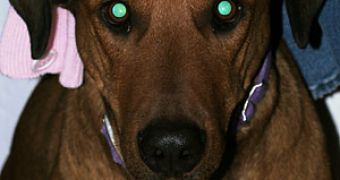Dogs have evolved from wolves. And wolves are nocturnal predators; you can see that very well by analyzing the behavior of stray dog packs. The same dogs that seem very quiet and calm during the day will attack any human passing through their "territory" at night.
Indeed, at night or in a forest, eyesight does not help much during the hunt, but smell does. Dogs "see" a world of smells. In humans, the olfactory mucosa is about 10 square centimeters, in dogs it's 150! For us pure salt is inodorous, quinine too. But a dog will detect them even dissolved at 1:10,000.
Their hearing is also sharper than ours: they detect ultrasounds (the bats' sonar must be a nightmare for them).
But with the eyesight, it's another story. First of all, dogs are myopic, or nearsighted, and this increases with age. They have binocular vision like ours, at some 180 degrees, but weaker. They are also color blind, detecting mainly degrees of color intensity as various shades of gray; their eyes are more wired for detecting movement, helping hunting and survival. The fovea, the eye's focusing spot, is not as evolved as in humans, decreasing a dog's ability to have the clear vision that humans have. Dogs possess a poor sense of depth, distance, and detail.
This is the situation during the day. But at night, they have an advantage over us. "Dogs have evolved to see well in both bright and dim light, whereas humans do best in bright light. No one is quite sure how much better a dog sees in dim light, but I would suspect that dogs are not quite as good as cats," said Paul Miller, clinical professor of comparative ophthalmology at University of Wisconsin-Madison.
"Dogs can probably see in light five times dimmer than a human can see in." said Miller. Dogs have a larger pupil than humans, letting them gather more light when scarce. Their retina has more night-vision cells (rods) than ours does, which react to lower light amounts than cones, but do not inform about color.
You know that a dog's eyes (and of all carnivores) glow in the tapetum, the biggest anatomical advantage of the dogs and other meat-eaters, and also in crocodiles. The tapetum is a mirror-like layer in the back of the eye reflecting the light, and enabling the retina to be turned on twice by the light that has penetrated into the eye. "Although the tapetum improves vision in dim light, it also scatters some light, degrading the dog's vision from the 20:20 that you and I normally see to about 20:80", Miller added.

 14 DAY TRIAL //
14 DAY TRIAL //